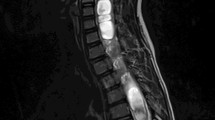Abstract
The authors analysed the clinical and radiological findings and the surgical management of 25 patients admitted for scoliosis classified as idiopathic at first presentation, but in fact associated with spinal cord and/or brain stem anomalies. Twenty patients had syringomyelia, 19 had Chiari malformation. Scoliosis was the only presenting symptom when all these patients were referred to the orthopaedic surgeon. On examination, five patients had normal neurological findings, while the others showed very mild neurological deficits. The diagnosis of syringomyelia and Chiari malformation was established by MRI, which is the best form of neuroradiological examination for discovering spinal abnormalities. Neurosurgical treatment is strongly recommended as the first step in the management of “pseudo” idiopathic scoliosis.
Similar content being viewed by others
References
Aboulker J (1979) La syringomyélie et les liquides intra-rachidiens. Neurochirurgie 25 [Suppl 1]: 9–132
Arai S, Ohtsuka Y, Moriya H, Kitahare H, Minimi S (1993) Scoliosis associated with syringomyelia. Spine 18: 1591–1592
Barnes PD, Brody JD, Jaramillo D, Akbar JU, Emans JB (1993) Atypical idiopathic scoliosis: MR imaging evaluation. Radiology 186:247–253
Blake NS, Lynch AS, Dowling FE (1986) Spinal cord abnormalities in congential scoliosis. Ann Radiol 29: 237–241
Bradford DS, Heithoff KB, Cohen M (1991) Intraspinal abnormalities and congenital spine deformities: a radiographic and MRI study. J Pediatr Orthop 11:36–41
Depotter J, Rigault P, Pouliquen JC, Padovani JP, Hirsch JF, Regnier D, Besson G, Touzet PH, Guigand O, Guyonvarch G (1987) Syringomyélie et scoliose chez l'enfant et l'adolescent A propos de 14 cas. Rev Chir Orthop 73:203–212
Forin V, Hautefort P, Beauvais P, Zerah M (1990) Scoliose et syringomyélie de l'enfant. A propos de 10 cas. Ann Réadaptation Méd Phys 33:449–459
Isu T, Chono Y, Iwasaki Y, Koyanagi I, Akino M, Abe H, Abunmi K, Kaneda K (1992) Scoliosis associated with syringomyelia presenting in children. Childs Nerv Syst 8:97–100
Lena G, Boudawara Z, Genitori L, Cavalhero S, Choux M (1992) 14 cas de syringomyélie communicante associée à one malformation de chiari type I chez Fenfant. Neurochirurgie 38: 297–303
Lewonoswski K, King JD, Nelson MD (1992) Routine use of magnetic resonance imaging in idiopathic scoliosis patients less than eleven years of age. Spine 17:S109–115
Muhonen MG, Menezes AH, Sawin PD, Weinstein ST (1992) Scoliosis in pediatric Chiari malformations without myelodysplasia. J Neurosurg 77:69–77
Nohria V, Oakes WJ (1991) Chiari I malformation: a review of 43 patients. Pediatr Neurosurg 16: 222–227
Nokes SR, Murtagh FR, Jones JD, Downing M, Arington JA, Turetsky D, Silbiger ML (1987) Childhood scoliosis: MR imaging. Radiology 164:791–797
Noordeen MHHH, Taylor BA, Edgar MA (1994) Syringomyelia. A potential risk factor in scoliosis surgery. Spine 19:1406–1409
Oldfield EH, Muraszko K, Shawker TH, Patronas NJ (1994) Pathophysiology of syringomyelia associated with Chiari I malformation of the cerebellar tonsils. Implications for diagnosis and treatment. J Neurosurg 80: 3–15
Phillips WA, Hensinger PN, Kling TF (1990) Management of scoliosis due to syringomyelia in childhood and adolescence. J Pediatr Orthop 10: 351–354
Samuelsson L, Lindell D, Kogler H (1991) Spinal cord and brain stem anomalies in scoliosis. MR screening of 26 cases. Acta Orthop Scand 62: 403–406
Williams B (1979) Orthopaedic features in the presentation of syringomyelia. J Bone Joint Surg [Br] 61: 314–323
Author information
Authors and Affiliations
Rights and permissions
About this article
Cite this article
Emery, E., Redondo, A. & Rey, A. Syringomyelia and Arnold Chiari in scoliosis initially classified as idiopathic: Experience with 25 patients. Eur Spine J 6, 158–162 (1997). https://doi.org/10.1007/BF01301429
Received:
Revised:
Accepted:
Issue Date:
DOI: https://doi.org/10.1007/BF01301429




